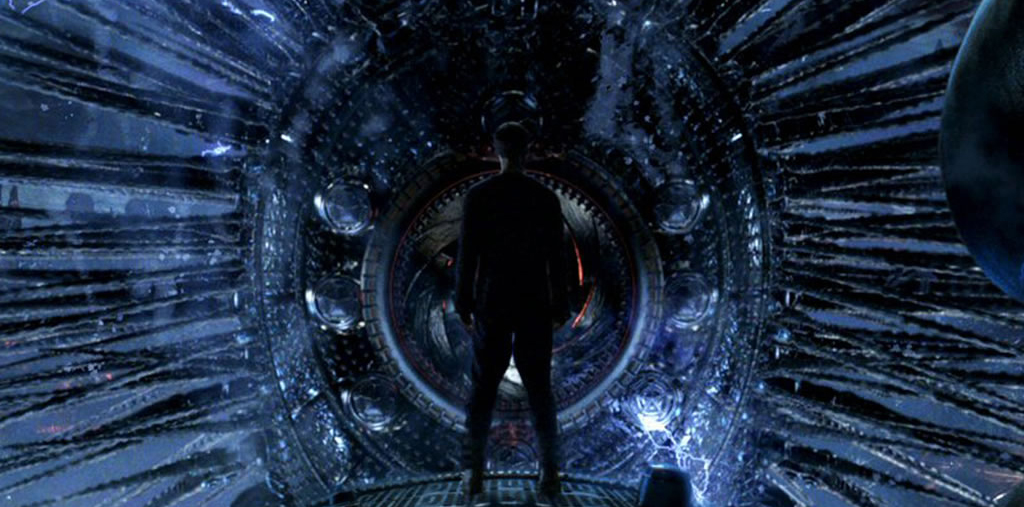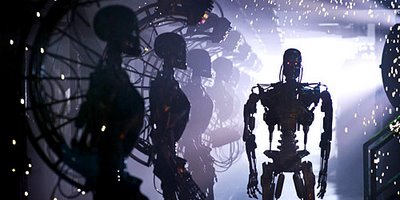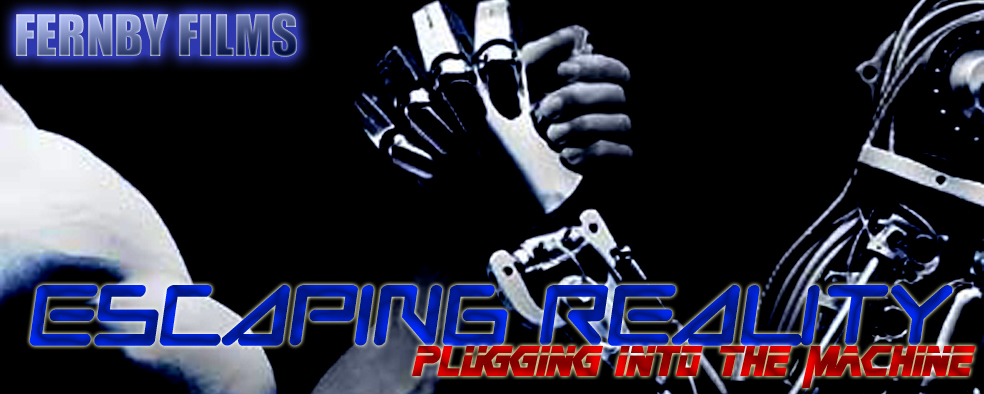Escaping Reality – Plugging into the machine…
It’s a strange paradox that’s evolved since the birth of the World Wide Web, where humans have become closer than ever before while gradually losing our ability to connect. Social networking has become the buzzword of the first decade of this new century, with major websites MySpace and Facebook leading the way, often to the detriment of actual human interpersonal relationships. The fact that we now have the ability to connect with anybody, anywhere in the world, at the click of a mouse button, has led to a dilution of social depth filled with Tweets and Status Updates no longer than a paragraph at best. Rather than a handful of real, actual friends with whom we have genuine bonds and interaction, we’re left with a gaggle of world wide networking “friends” that have no meaning in our lives save for bolstering our increasingly bloated “friend list”.
We look at Hollywood’s fascination with the Man vs Machine story, and why these films are so successful…
It’s a strange paradox that’s evolved since the birth of the World Wide Web, where humans have become closer than ever before while gradually losing our ability to connect. Social networking has become the buzzword of the first decade of this new century, with major websites MySpace and Facebook leading the way, often to the detriment of actual human interpersonal relationships. The fact that we now have the ability to connect with anybody, anywhere in the world, at the click of a mouse button, has led to a dilution of social depth filled with Tweets and Status Updates no longer than a paragraph at best. Rather than a handful of real, actual friends with whom we have genuine bonds and interaction, we’re left with a gaggle of world wide networking “friends” that have no meaning in our lives save for bolstering our increasingly bloated “friend list”.
The fact that social networking on the web has led to a fracturing of actual relationships, rather than an improvement of them, is indicative of the apparent human desire to live our lives in a world of electronic bytes and disconnected “pokes”. We’d rather update our status than go out and meet people. Apparently.

Using this kind of new age thinking, it’s appropriate that we dissect a current thematic trend in Hollywood over the last decade. Recently, I had the pleasure of perusing a couple of similarly themed films, Gamer and Surrogates, and it struck me that Hollywood has really embraced the concept of a humanity so isolated from itself that we resort to a kind of avatar lived lifestyle. The Matrix (1999) took us into an alternative world where humans lived in a state of induced hallucination. For many fans, the idea that we could live in a world where bullet time existed was almost too much: and the film asked the question of us… are we indeed living in a world run by our minds? Recent films such as Gamer, which had a psuedo-Crysis style theme of humans controlling others via a web-based mind link, and Surrogates, where humans lived in their houses and controlled robotic representations of themselves out in the world, have tapped into the theme of living our lives through some sort of fantasy. Even Avatar, James Cameron’s most recent blockbuster, swam with the theme of living a life outside your own body via a machine connected to a constructed body: so the themes of externalising our lives have really taken hold in recent years. Robin William’s role in Final Cut even went to the extreme of having our memories recorded and edited down upon our death for our loved one’s edification – admittedly no direct “machine” interaction occurred here, but the film portrayed our lives as being little more than a series of adventures recorded on a machine in our brains.
For the sake of argument, we’ll focus our arguments on a few films which capture the essence of the man-machine theme in film: The Matrix, Surrogates, Gamer and Avatar. No doubt there are others we’ve forgotten about, but these in particular stand out in the public conscious.

At the end of the last millennium, the Wachowski Brothers gave us a seismic shift in cinema with their breakthrough direction on The Matrix, a mind bending story about man’s struggle to disengage from our machine captors. Using state of the art CGI, a mix of martial arts and gun violence, and a combination of religious, philosophical and social ideologies, The Matrix was an intelligent, entertaining example of science fiction, with a mythology akin to Star Wars. In the years since The Matrix was released, we’ve been privy to two sequels, an animated apocrypha and many, many reviews and articles about what the film actually means. While the analogous narrative of the two Matrix sequels is nowhere near as well defined as in the original film, there was plenty to glean from the companion short films, collectively entitled The Animatrix. Man’s struggle for identity, against a faceless and unfeeling enemy, has long been a staple of science fiction films through the years, although the theme hasn’t been (and probably never will be) as brilliantly conceived as it was in 1999. What the Wachowski’s managed to do was tap into our primal fear of losing control; the machines rule our world, and subjected us to a fantasy life lived in a machine. Which is a common element in each of our films today.
Surrogates, one of the three films we’re looking at here that was released in 2009, also examines what society would be like were we all plugged into a machine. The idea of robotic synthetics living our lives for us, controlled by our atrophying bodies elsewhere, was hinted at in Pixar’s WALL-E, in which humans had become so lazy that we lived our lives in chairs that gave us all our desires. Jonathan Mostow’s Surrogates takes this to the n-th degree, by having most of human society consigned to living fake lives via fake-humans. Is it human laziness that drives us to fantasise about having a robot to do our work? Or a genuine sense of isolation, a disconnection with reality begun with video games and Facebook? Gamer, starring Gerard Butler, highlighted the way in which humanity would readily abuse an avatar-based lifestyle, with it’s use of humans in a real-live SimFamily game (as well as the film’s central conceit, the Slayers 3rd Person Shooter format) by having all kinds of sicko perverts living their dreams out on mind-controlled humans. It’s a depravity we’ve seen all to often, mind you, on sites like Facebook and other networking access points, with the cruel and sick using this platform as a way of satisfying their own desires.

Avatar, on the other hand, avoided the darker side of human nature (to an extent) by having the use of a machine to plug into being a source of scientific endeavour, a more purposeful reasoning than simple emotional gratification. James Cameron’s film may not delve too deeply into the science behind the “avatar connection” itself, instead simply using this principle to further its story, but it does highlight some of the positive aspects to this kind of idea. While lead character Jake Sully is initially overjoyed to be inside his “avatar”, by the end of the film his link to it becomes a critical factor to his own survival, a dependency that he’s reluctant to overcome due to his pre-existing paraplegia. The “machine” in Avatar is used for an altruistic purpose, a device of empowerment rather than overpowering oneself.
In all the focus films save Avatar, the machines work to the detriment of society: The Matrix has machines with artificial intelligence trying to kill us, Surrogates has machines living our lives for us, and Gamer has machines taking over humanity via the element of fantasy. Many have hypothesised what would happen should machines gain sentience, much like the Terminator movies (which killed us all); would machines recognise us as their masters, or turn on us in self-defence? In the world of the Matrix, machines have turned like worms. Humanity is plugged into a fantasy world, powering the machines’ with our own body heat. The Animatrix’s opening salvo, the two part The Second Renaissance, gives us a biblical Genesis-styled history of humanity’s downfall to machines. Retrospectively, there are two key moments in The Matrix which pretty much sum up our thoughts today. The first is the now oft-parodied scene where Morpheus asks Neo if he wants the red pill or the blue pill. Neo isn’t sure, although he eventually chooses the “right one”. As an audience, we’re not sure what he’s getting into. The second moment, which is indicative of The Matrix’s portrayal of the machines’ contempt for us, is when Neo, having taken the red pill, wakes up in the “real world” and is subsequently flushed down a waste tube like a steaming turd. The fact that the machines have gone to the trouble to actually build a “waste tube” for the human detritus is telling. This second scene, had it taken place prior to the red pill/blue pill scenario, would have given us clarity on the entire film. The Wachowski’s, in their wisdom, chose not to show us the real world until, like Neo, we’d woken from our induced coma.

Hollywood’s fascination with machines ruling humanity traditionally has us trying to overcome the imbalance: machines, by their very nature are more resilient to damage than our own tender flesh, and consequently any violence depicted is always fairly one-sided. Matrix machines, as well as the carbon-copy robots in Surrogates, are hard to kill, if it’s possible at all. With the less intrusive vision in Gamer and Avatar, however, machines are a means to an end. Humans still exist to interact, but the machines allow an escape, albeit temporarily. Admittedly, the Gamer example is buried by directors Mark Neveldine and Brian Taylor by a cacophony of sound and fury, but the underlying message is still there to be found, if you’re prepared to work for it.
Gamer’s example begs the question: if humanity (society) is given free rein to fantasise about anything, why is it more often than not, the fantasy is for violence or sex? Gamer leans definitely towards the former, although it does touch upon the latter in a way which is quite confronting. The domination of porn on the web is indicative of our addiction towards sexual behaviour. The domination of video games seems to lean towards violence and killing, as seen by any top ten list of PlayStation, X-Box or Nintendo variants. The video game industry doesn’t even try and hide the fact. Gamer takes this obsession with pixelated death and carnage and puts it into the real world, to horrific consequences. The dehumanisation of western society isn’t too far from Gamer’s pointed reminder as to the abuse of the power over life and death. Is the world of Gamer that much distant from our own? Perhaps not. The predominance of the world of commerce, and the pursuit of money over everything else, will come to naught should machines remove the safety valve of common sense and decency.
Surrogates takes a different tack, with humanity completely subjugated (with its own permission, mind you) by the robotic constructs we’ve decided to use in place of ourselves. Surrogates leans more towards a vanity styled approach to robotics, a fantasy of humanity to have “robots do all the work” come true. The robots in Surrogates are ciphers, mere machines under our control, although while they may not possess an intelligence of their own, their existence underlines man’s folly of using machines to our own detriment. Surrogates asks us if complete reliance (and use of) on robots to do all our work is a good thing: the disintegration of human interpersonal relationships is probably the biggest negative seen in the film. Bruce Willis’ character is devoid of any closeness with his wife, due in part to the loss of their child, and also due to the use of surrogates to close off any kind of “real” emotion.

Most sci-fi films of the last decade or so generate their conflict from the age old paradigm (which was produced so pointedly in Spielberg’s Jurassic Park) that “they’re so busy trying to figure out if they can, they don’t stop to think if they should“. The Matrix’s historical mythology, where machines were given AI (to our doom), Gamer’s plot point of having society blinded to just how bad Slayers is as a game, and Surrogate’s turgid societal norm of using machines to live our lives, indicate where we’ll go if we don’t start to regulate what science and technological development should be used for. Japanese advances in robotics are beginning to emulate the world we saw in I, Robot, with lifelike humanoid robots getting smarter and smarter, to the point they’re now displaying “emotion”!
So why are films about machines run amok so successful, at least today? I think it’s due mainly to the fact that machines, which are traditionally soulless, empty constructs of our own design, have so much potential to bring about our own ruin that it fascinates filmmakers everywhere. It certainly fascinated the Wachowski’s. The fact that we are reliant on machines, and their ability to control us simply by existing (as is the case with Surrogates) or gaining sentience (as is the case with The Matrix), means a threat from them is not all that far removed from being factual. This will always touch a nerve with viewers. We create something, which in turn tries to kill us, or subjugate us in some way as to remove free will from our lives. Surrogates, for example, appears to have removed the ability to socialise in a normal, human way; we rely on machines for it. Of course, many films touch on the destruction of humanity due to our own negligence or short-sightedness, and indeed the themes of many of these films remain constant today. The onward rush of technology before we’re ready for it, the reliance of our lifestyle on that technology, and our own folly in believing that we are masters of our own destiny.

Steven Spielberg’s vastly underrated attempt to do a Kubrick, 2001’s AI: Artificial Intelligence, took us to the other side of a man vs machine battle, where in the darker underworld of used up machines, humans put them to the sword in numerous ways. When David, a robot with artificial “feelings” is dumped by his bereaved “mother”, he accidentally wanders into an anti-mechanoid “Flesh Fair”, where robots are destroyed using all manner of devices for human entertainment. It seems not all of humanity is impressed with the ubiquitous robot, and we see the contempt for machine “life” writ large. Spielberg portrays this fear in a negative light, almost an animalistic approach to robotics, which for the sake of the film suits the narrative, but perhaps isn’t all that accurate in our own world. Where the story really takes your breath away, however, is when David attempts to convince the humans in charge that he is, in fact, a real boy. He isn’t, but he’s programmed to believe otherwise, and it’s his plaintive cry of being “real” that tears at your heartstrings. Are we that far from achieving this kind of synthetic perfection? And if so, will we choose to accept it, or will we find it too… creepy. The problem with artificiality is that the closer it gets to being real, the further we’ll go to avoid it. We don’t want robots to look like us. We want robots to look like robots. The Matrix never considered this approach, however Surrogates can focus our attention on this problem. Surrogates has the machines, the robots, looking like perfect, blemish free versions of ourselves. Ostensibly this fantasy would make people orgasm on the spot if they could have a chance to be like this, but where I think Surrogates gets it right, is in humanity’s gradual, insipid, de-volvement as a species to where we can only function via the conduit of a machine.
Take, for example, relatively recent attempts to create realistic humans on film, starting with probably the most original CGI film to come out of Hollywood, Final Fantasy: The Spirits Within. While CGI technology was pushed to its limit in that film, we begin to see just how bizarre created realism can be. The human characters in Final Fantasy looked quite good, in fact, but they were missing something behind the eyes: a soul. The character gave of creepy undead vibes, like zombies in a sense, that made most audiences just a little unnerved. Much the same can be said for performance capture films like The Polar Express and Beowulf, to name two, where human beings are created inside a computer. With both Beowulf and Polar Express, however, the “soul” of the characters is missing. This is explained simply: no matter how much processing and memory we can give a computer, they are as yet unable to capture the true essence of a human being, its soul. We’re close, I know. Beowulf, the Zemeckis Christmas Carol and the upcoming Tintin series will all remind us of this fact. Eventually, human actors will be replaced with digital ones; and not just as crash test dummies in major effects sequences like Spider-Man, but as actual actors capable of delivering a performance alongside Meryl Streep or Robert DeNiro. It’s not a matter of time, it’s a matter of processing power.

Which goes to prove my point, though, that machines will at some point be capable of appearing to be entirely human, while not actually being human. This fear is being realised by Hollywood’s story tellers, as they seek to enlighten us as to the pitfalls of what can happen if machines become smarter than us. It’s a long bow to draw to suggest that society will follow any of the paths predicted in our films here today; many have predicted a more Star Trek-like model will endure, which I also think is a long way off. I think it’s fair to say that the altruistic behaviour of humanity in a utopic society will remain in the realm of cinematic fantasy for at least the next few generations; unless the Mayan prediction of a massive cataclysm comes true in 2012. Thankfully, Hollywood will continue to mine the vast quarry of machine vs mankind storytelling.

